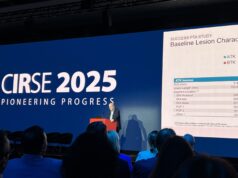
Sabine Steiner (University of Leipzig, Leipzig, Germany) took to the podium at this year’s Leipzig Interventional Course (LINC 2024; 28–31 May, Leipzig, Germany) to share, for the first time, two-year data from the BEST SFA randomised controlled trial (RCT) and final, five-year results from the COMPARE study.
BEST SFA
Steiner first revealed the latest findings from BEST SFA. By way of background to the trial, the presenter highlighted a discrepancy between the available evidence—which she noted focuses mainly on single devices and short- and intermediate-length lesions— and the “much more complex” superficial femoral artery (SFA) disease requiring the use of multiple devices that clinicians face on a day-to-day basis.
“The additive value of adjunctive therapy is unclear,” Steiner pointed out. As a result, she and colleagues sought to run an exploratory pilot study comparing strategies rather than single devices in very complex, real-world SFA lesions without restricting the use of adjunctive devices. “Actually,” the presenter highlighted, “we were encouraging the use of these devices for vessel preparation.”
In the investigator-initiated, industry-independent BEST SFA RCT, 120 patients with Rutherford category 2–4 disease were randomised in a 1:1 fashion to either a stent-preferred or a stent-avoiding treatment strategy. Steiner informed the LINC audience that both strategies had to be feasible according to the operator.
With regard to lesion characteristics, Steiner underscored the complex nature of the SFA disease treated in the study. The mean length of the included lesions was 18–19cm and around 80% were chronic total occlusions (CTOs).
At two-year follow-up, Steiner reported a freedom from clinically driven target lesion revascularisation (CD-TLR) rate of 84% in the stent-preferred group and a 78% rate in the stent-avoiding group. There were no major amputations during this time period.
“We had a high bailout stenting rate and high rates of residual stenosis, which might explain a relatively significant loss of patency at two years,” the presenter continued. “However, the freedom from TLR rates are really promising, and we will continue to follow these patients.”
COMPARE
Later in the same session, Steiner shared final, five-year results from the COMPARE study.
“The COMPARE RCT has quite a unique study design,” the presenter began, noting that this was the first head-to-head investigation of two drugcoated balloons: one with a lower dose of paclitaxel (Ranger; Boston Scientific) and another with a higher dose (IN.PACT Admiral; Medtronic).
The study had a non-inferiority design, enrolling 414 patients with femoropopliteal lesions who were stratified for lesion length—up to 10cm, 10–20cm and 20–30cm, with a third of the patient population in each group. The patients were randomised 1:1 to treatment with either the ‘low-dose’ or ‘high-dose’ DCB.
“Non-inferiority was met for both the primary efficacy and safety endpoints,” Steiner informed the LINC audience, recalling data presented at LINC 2020.
Moving on to the new, five-year results, Steiner reported: “We do not see a significant signal for a difference between these balloons and we have a freedom from TLR rate of around 67% for the lowdose group and about 75% for the high-dose group after five years of follow-up.”
Furthermore, Steiner shared that short lesions (up to 10cm) “did very well,” stabilising earlier on with respect to CD-TLR and with a freedom from TLR rate of 80–85% at five years.
The presenter outlined “a similar picture” with lesions of 10–20cm in length, pointing out a stabilisation of reintervention after two years and a freedom from TLR rate of around 66–75% at five years.
With regard to long lesions, Steiner underlined the fact that there were more reinterventions in this group, adding that more than half of these lesions were free from CD-TLR at the five-year time point.
Finally, closing her presentation, Steiner shared that no signal for increased mortality or amputations were seen in either group.













